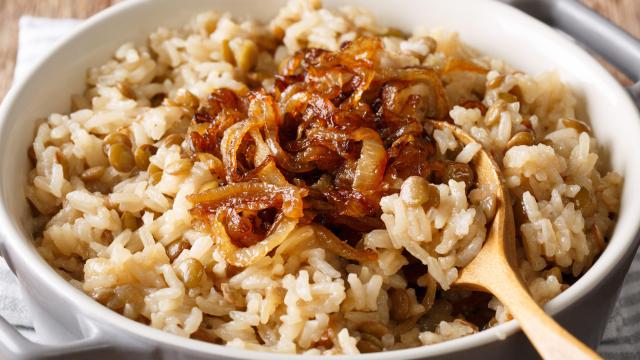I, like so many millennials, am a big fan of instant gratification and am always looking to hack, streamline, or otherwise speed up the process of cooking delicious food. There is, however, one tasty treat that is always going to take its sweet, caramelized time: the onion.
As Tom Scocca pointed out in his takedown of lying food writers who lie about caramelizing onions, this is a process that is going to take at least half an hour, but probably more. You’re not simply getting colour on these alliums; you’re breaking down long chains of sugar molecules into single sugar molecules, and further breaking those sugars down into smaller, flavorful molecules to get a sweeter, deeper tasting, not simply charred onion. Adding a bit of baking soda can speed things up a little, but you’re not going to get there any faster by increasing the heat.
Get the tools you need for caramelizing (or frying) onions:
- A mandoline, for uniform slices
- A big ol’ pan
- Wooden spoons, for stirring and scraping
As such, the main ingredient in caramelized onions, besides onions, is patience. You need to cook these babies over low—not medium—heat. I am not a patient person, so the key is to have a series of other, five-minute tasks you can complete while you are leaving those onions the heck alone. Here’s how I do it:
- Slice or chop an onion fairly thin, but not too thin, as paper-thin onions will want to fry and crisp, not caramelize.
- Add them to a pan heated over low heat, along with a tablespoon of cooking oil. (Butter will seem to speed the process up, but then you’re browning butter, not onions).
- Season the onions with salt to flavor them, but also to help draw out water.
- Chill out and do something else for five minutes; maybe take out the trash or clip the dog’s toenails? (Just kidding; clipping a dog’s toenails is a battle that takes at least 24 minutes.)
- After five minutes has elapsed, give them a stir.
- Repeat steps 3 and 4, completing short, mundane tasks in between each stir session.
- If you are a cheeky monkey, and sneak the heat up a few degrees, you may notice your onions are starting to get crisp at the ends. Decrease the heat. If you have spots of burnt fond, add some water, scrape it up, and continue cooking.
- Remove the onions once they are as dark as you like them. For a barely browned, golden onion, this is around 25 minutes. For one with a deep, caramelized flavour, you will need to wait at least 35, but probably closer to 40.
- Use the onions as you wish; stir them in a soup or dip, pile them on a burger, layer them into a grilled cheese, scramble them into eggs, or just eat them by the spoonful.
If you do not believe me, and wish to rush the process by cooking them over a higher heat, that’s fine, you will get some colourful, flavorful onions, but they will be fried, and I have the pics to prove it. (The reason I have these pics, if I am being fully transparent, is because I—the one who should know better—tried to speed up the process of caramelizing onions.)
Of course, fried onions can hardly be called a “mistake.” It’s not like you can’t add them to burgers, dips, or your wide-open mouth, so it’s not a huge loss. But they’re not exactly the same as soft, caramelized, sweet, sweet onions.

Leave a Reply
You must be logged in to post a comment.